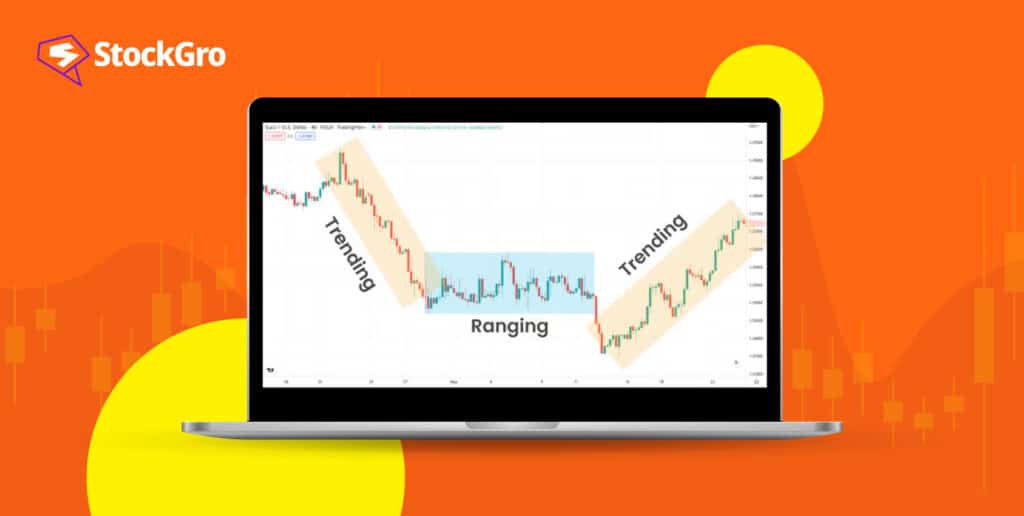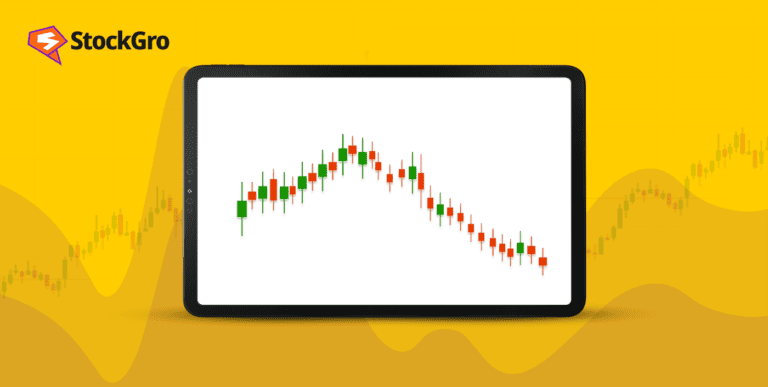
Introduction
You may have come across the term ‘range-bound’ in reference to Nifty and Sensex. This is a common phenomenon in equity markets where prices oscillate within a specific range for a certain period. When these markets eventually break out of this range, it can present significant profit opportunities for traders.
However, predicting the timing and direction of these breakouts can be speculative, often leading to potential trading losses. Instead, traders can consider range-bound trading.
This strategy capitalises on the predictable price movements within the defined range, thereby minimising risk exposure and maximising profit potential.
What is a range-bound market?
As the name suggests, a range-bound market is a situation where a security’s price, such as a stock’s price, commodity’s price, or crypto’s price, remains within range. The price oscillates between a specific high price and a low price for a certain period.
Here, the high price acts as a resistance level that the security struggles to break through, while the low price serves as a support level where the security tends to bounce back.
This constant bouncing between the support and resistance levels creates a ‘range’ that the security is ‘bound’ by, hence the term ‘range-bound market’. In a range-bound market, the market does not exhibit a significant trend in any direction.
Prices typically oscillate, reaching previous highs before retreating to former lows.
Also read: Do all technical analysis tools work equally well?
How to identify a range-bound market?
Recognising a range-bound market necessitates a sharp eye and a deep comprehension of market trends.
Traders can spot a market that is ranging by keeping an eye on the market’s support and resistance levels and pinpointing the best spots to set entry and exit orders.
Technical indicators like the average directional index (ADX) and Bollinger Bands can also be used to verify that the market is in a trading range.
ADX
The ADX is an indicator of trend strength that can assist traders in determining whether the market is trending or ranging. A reading below 25 on the ADX indicates that the market is range-bound, while a reading above 25 suggests a trending market.
For better understanding: What is ADX indicator? Make informed trades by tracking market trends.
Bollinger Bands
Bollinger Bands, a volatility indicator, can also be used to identify range-bound markets. It consists of a moving average line with two standard deviation lines above and below it.
When the price of the security touches the upper or lower Bollinger Band, it indicates an overbought or oversold market condition, respectively, suggesting that the price is likely to revert to the mean.
Options strategy for range-bound market
Here are some of the option strategies that traders can utilise for the range-bound market:
1. Iron condor strategy:
To set up an iron condor, a trader does two things at once. They sell a put and a call option that are not likely to be exercised (out-of-the-money). Then, they buy a put and a call option that are even less likely to be exercised (further out-of-the-money).
The most they can earn from this strategy is the money they get from selling the options (the net premium). The maximum loss they can incur is the difference between the strike prices of the two options (call or put), subtracting the net premium they received.
2. Calendar spreads
In this strategy, you buy an option that lasts a long time until it expires, and simultaneously, you sell another option that has the same type and exercise price but expires sooner.
In a long calendar spread, the maximum profit is made when the stock price equals the strike price at the expiration of the short call. The maximum loss is the total cost of the spread.
3. Short strangle or straddle
In a straddle strategy, a trader can sell an at-the-money (ATM) call and put options.
However, if traders think the price will move a lot, they can opt for a short strangle strategy, where they can sell out-of-the-money (OTM) call and put options that are not likely to be exercised.
In both cases, the most they can earn is the money they get from selling the options (the premium), but the loss could be unlimited.
Must read: The ABCs of stock market: Consolidation and Breakouts
Is range-bound trading effective?
Range-bound trading can be an effective strategy, especially in a stable market where the price of the security is not making significant moves up or down. This enables traders to reap profits from minor price fluctuations within the range.
However, it is important to note that this strategy requires careful monitoring of the market, as a breakout from the range can lead to losses. Further, to employ range-bound trading, traders must have a good grasp of technical analysis and the fundamental elements that influence an asset’s price range.
This strategy involves purchasing at the lower trendline, known as the support, and selling at the upper trendline, known as the resistance.
This allows you to capitalise on the temporary peaks and troughs within the range, potentially leading to market gains.
When you are dealing with range-bound markets, ensure that you verify the range before initiating any buy or sell orders.
Who should use range-bound trading?
Range-bound trading is best suited for investors who are patient and are comfortable with waiting for the price to reach the desired levels. In such cases, traders will preferprofiting from the oscillations of an asset’s price within a certain boundary, rather than forecasting the broader market trend.
This strategy can be beneficial for those who aim to execute short-term trades and exploit the price variances within a clearly delineated range. It is fair to say that it is well-suited for those who lean towards a more cautious trading strategy.
However, it necessitates a solid grasp of technical analysis and options trading.
Bottomline
Becoming proficient in navigating markets that do not have a strong trend can be a great asset for any trader, helping traders to make gains even when prices are not moving significantly on either side.
But remember, like all trading strategies, it demands consistent practice, self-control, and a deep knowledge of how markets work. Note that it is not a universal trading strategy that fits everyone. The most effective strategy often varies depending on the trader’s style and their comfort with risk.
